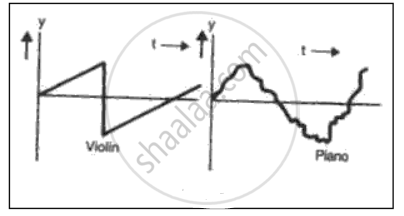Advertisements
Advertisements
प्रश्न
उत्तर
| Longitudinal waves | Transverse waves |
| 1. As it travels through a medium, the particles of the medium vibrate to and fro about their mean positions along the direction of propagation of wave. 2. As the wave propagates through the medium, it causes compressions and rarefactions. 3. In case of longitudinal waves, one wavelength contains one compression and one rarefaction. 4. They can travel through all media i.e. solids, liquids and gases. 5. As the longitudinal wave propagates through a medium, there is change in density of the medium. |
1. As it travels through a medium, the particles of the medium vibrate perpendicular to the direction of propagation of wave. 2. As the wave propagates through the medium, it produces crests and troughs. 3. In case of transverse waves, one wavelength contains one crest and one trough. 4. They can travel only through solids and on the surface of liquids. 5. As the transverse wave travels through a medium, there is no change in density of the medium. |
APPEARS IN
संबंधित प्रश्न
Select the correct alternative :
Wavelength is measured in
What are infrasonics? Can you hear them?
State the factors on which the pitch of a sound depends.
The longitudinal waves travel in a coiled spring at a rate of 4 m/s. The distance between two consecutive compressions is 20 cm. Find :
(i) Wavelength of the wave (ii) Frequency of the wave
We can distinguish between the musical sounds produced by different singers on the basis of the characteristic of sound called :
In fig. 2 two musical notes of the same pitch and same loudness are played on a violin and on a piano. Their wave forms are as shown in the diagram below. Explain why the wave patterns are different.

Select the correct option:
If the frequency of a wave is 25 Hz. the total number of compressions and rarefactions passing through a point in 1 second is :
What kinds of waves are produced in solids, liquids, and gases?
What causes sound in air?
